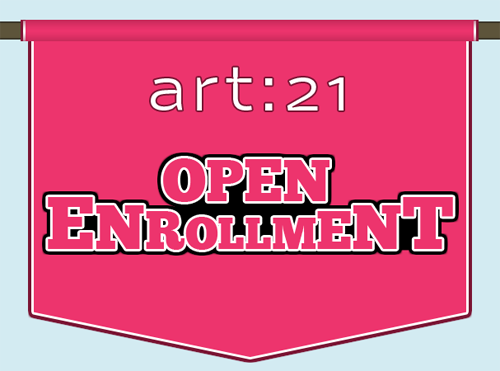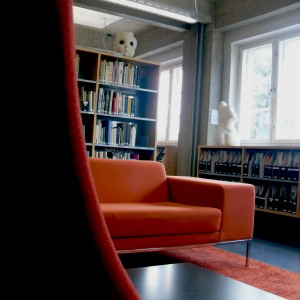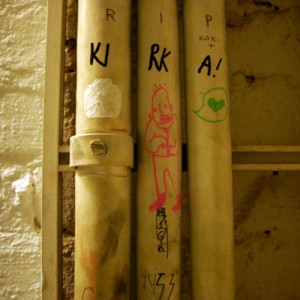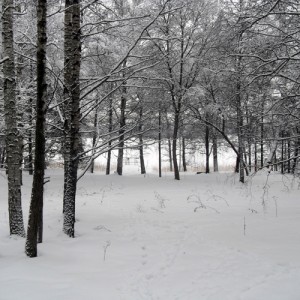“We live in an age where the artist is forgotten. He is a researcher. I see myself that way.” — David Hockney
Sometime in the afternoon on the second day of hanging a recent installation of my work at a gallery space at school, I was approached by one of my professors. He asked if the exhibition was related to my research.
I found myself unable to come up with an appropriate answer. After three cups of coffee and nary a drop of water, I was finding it hard to focus: a fluorescent light flickered in my peripheral vision. I looked at the spectrum of bold, metallic and iridescent craft papers cut into the patterns of American pinwheel quilts; I didn’t see an immediate connection between this work and the work I had been doing a few days earlier, reading feminist revisionist history in the library.
Drained but buzzed, I mumbled, “Not really, not exactly.”
The beginning of my second semester as a student at Aalto University marks the halfway point of my time in Finland. As a student at this leading design center, the question of research and its relationship to my artistic work has continued as a reoccurring concern both to me and among my peers.
For starters, a Fulbright Grant brought me to Helsinki last August. Months of research had resulted in a carefully-crafted proposal to study textile design and live in Helsinki, the 2012 World Design Capital. Many of my fellow grantees are engaged in more traditional forms of research— processing data in a lab or researching for a dissertation. A fellow Fulbrighter from my apartment building studied sleep deprivation in a laboratory. Often starved for conversation after a day of unintended silence, I would listen raptly to her day which would sometimes involve the termination of rats whose “services” were no longer needed.
Artists are like rats. We work incessantly, often for no or little apparent gain. Sometimes we are dirty. Most importantly, we operate on an input-output basis. We must become savage foragers in order for our creative work to thrive. This is how the concept of research enters the picture.
Last semester, I took Professor Juha Varto’s seminar on Contemporary Art and Research Practices. Professor Varto is a Finnish philosopher who has been working with artists for over a decade. His work in Finnish educational institutions has concentrated on research methodology. Every class, we read an article or text that pondered the question of research and artists and how these two categories interact. My classmates in this seminar were mostly PhD candidates in the Department of Art at Aalto University. They often bemoaned the difficulty of simultaneously writing and making, understandably. Together we circled over and over back to the same questions: Can you be a good writer and a good artist at the same time? Can academic work stifle one’s art? What constitutes research for artists?
An academic setting can potentially desiccate an artist’s output (or more specifically, certain types of output that function outside established systems like academia); however, the abiding attitude toward art education is (at least here in Finland) is more is more. This country that prides itself on efficiency and utility for once adopts a maximalist approach.
According to Professor Varto, “Art has become two-way traffic: artists get and give. It requires special skills to be good at this. An artist must recognize her customs, skills, history and idiosyncrasies … She simply must know a lot and also know why she must know a lot.” I agree. I believe that as artists, our hunger for the acquisition of knowledge must be unequivocally matched by our desire to create. Making art that is singular in its focus simply fails to communicate to a broad audience.
As artists, if we acknowledge that wholly idiosyncratic and individualistic work has been edged out of relevant contemporary art, then we are likewise ceding to the importance of knowledge and therefore, education.
When my days in graduate school at the Cranbrook Academy of Art were reaching their end, I briefly looked into PhD programs in the United States. The thought of carving each individual stone along the path as an artist terrified me. It still does. Two years ago I never imagined that I would be studying and living in Helsinki. Where I will be two years from the present is certainly unclear.
Like rats, the uncertainty of survival lends itself to opportunistic behavior. But easy answers are often bad answers. Likewise, with research and art—we should be wary of what comes too quickly. Jumping into the ranks of academia may also simply be the safest choice — easily said from someone who has yet to extricate herself completely from the aegis of academia.
Again, Professor Varto: “The history of Enlightenment with its focus on theoretical knowledge and reason has emasculated the human experience into a measuring gauge, to statistical knowledge… How can we have strong concepts without becoming overly simplistic and idealistic? We need art teachers (in schools and universities) who are able to show the world as a whole, as a complex unity, full of liaisons that are not seen by a bourgeois mind.” We might be rats, but statisticians we are not.
The artist must create the environment where her work can survive. This space can exist anywhere—in a PhD program, in a private studio, in a library, etc. Recent emphasis on PhD programs both abroad and in the States sidesteps the underlying issue: artists (myself included) should be more knowledgeable.
Before I moved to Finland, I learned one Finnish proverb: Onnelisuus on se paikka puuttuvaisuuden ja yltäkylläisyyden välillä. “Happiness is a place between too little and too much.” Artists need to engage with society in order to communicate meaningfully. We need to research and draw from our world to create these complex liaisons. However, too much research can often work at cross-purposes, making artists more out of touch with the everyday world the longer they haplessly haunt the ivory towers of academia. Not enough research and artists risk self-indulgence. We need to find the place between too little and too much.
Jacquelyn Gleisner is an artist currently living in Helsinki, Finland on a Fulbright Grant. As a visiting researcher at Aalto University, she studies design history, with a focus on the Finnish textile company Marimekko. She has a B.F.A. in studio art from Boston University and an M.F.A. in painting from Cranbrook Academy of Art. She has also studied at the Scuola Internazionale di Grafica in Venice, Italy. Her paintings have been exhibited in the United States and Europe.








Pingback: Art 21 Open Enrollment « hellosinki!